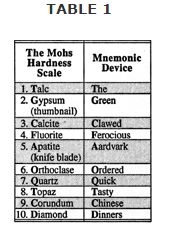It is often difficult to identify a mineral simply by looking at it, but each mineral has a set of distinctive characteristics that are easily tested in the field or laboratory.
Hardness. Hardness is distinctive quality of minerals that is determined by the Mohs hardness scale. Talc is the softest mineral on the scale at a value of 1, and diamond is the hardest at a value of 10 (Table 1). Geologists often scratch minerals with a knife blade that has a hardness of about 5. If the mineral scratches the knife, it is harder than 5; if the mineral is scratched, its hardness is less than 5. A thumbnail is about 2.5 on the Mohs scale. Most geologists can remember the hardness scale only by using a mnemonic device (Table 1).

Color. Although color should always be taken into consideration, minerals can frequently occur in a variety of colors. Chemical weathering also changes a mineral's external color. Scraping a mineral on a porcelain surface, or streak plate, leaves a distinctive colored streak that is more diagnostic of a mineral than its external color.
Luster. The luster is the appearance of the light that is reflected from a mineral's surface. Lusters can be metallic (shiny, like gleaming metal), glassy or vitreous (glazed like porcelain), or earthy (dull, not shiny).
Crystal form. Sometimes minerals have a distinctive crystal form that reflects a specific internal arrangement of atoms. The crystal form is best developed when the mineral can crystallize slowly from the fluid that contains its elements.
Cleavage. Cleavage is the tendency of a mineral to break along preferred crystalline planes that are weakly bonded. The angle between various crystal faces is often distinctive for different mineral groups and can be determined with a magnifying lens in the field.
Other properties. Other properties useful in mineral identification are the way a mineral fractures, its specific gravity (estimated by how heavy it feels), and whether it is magnetic or not.